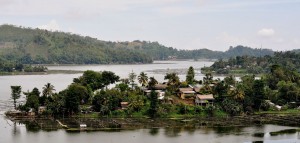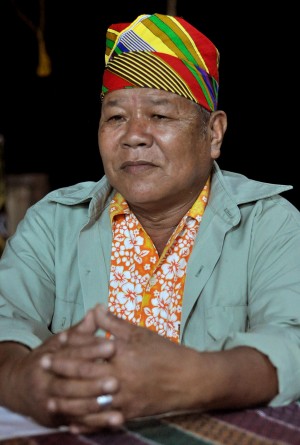
PROBABLY the most oppressed, and certainly the most neglected, Filipinos are the indigenous peoples (IPs) in every region of the country. Voters at party-list election should make them top priority, to give voice to the voiceless.
Stories of Aetas being shot at as if in target practice by bored American soldiers at Clark Field some years ago only show the status they’ve been relegated to—subhumans, if not animals. (The classic movie line “Ang kapatid ko ay hindi baboy-ramo” arose from those incidents.)
Recently in the news were the Lumad, those tribes that inhabit the mountains bordering Davao Gulf. The displacement of the Manobo tribe in Surigao del Sur came as supreme irony as it occurred just a few weeks before we’d start celebrating Indigenous Peoples Month.
While the United Nations observes Aug. 9 as International Day of the World’s Indigenous Peoples, the Philippine government has declared a whole month (October) to promote and protect IP rights, pursuant to Presidential Proclamation No. 1906 issued in 2009.
Our IPs are descendants of the country’s original inhabitants who were not absorbed by centuries of Spanish and American colonization, thus retaining their customs and traditions.
We have 12-15 million IPs (15-20 percent of the total population), belonging to 110 ethnic communities and speaking some 170 languages. The National Commission on Indigenous Peoples says 61 percent live in Mindanao (24 groups); 33 percent in Luzon (21 groups); 6 percent in the Visayas (13 groups).
Mysterious people
Lumad (Cebuano for “native”) is the collective term for the IPs of Mindanao, a name they started using in 1986. The most famous of them are the T’boli of South Cotabato.
The T’boli are still mysterious to most Filipinos, their identity and whereabouts often a question. They are one of those proverbial creatures that are often heard of but seldom seen. They trace their dim origins to the Great Flood.
They are medium of build, light of complexion, curly or straight of hair. In other words, they look exactly like most Filipinos.
What really distinguishes them, the visible signature of their identity, is the way their women dress and adorn themselves: elaborate costumes with vibrant embroidery; necklaces of multicolored beads; belts, bracelets and anklets with little brass bells; fancy hairdos adorned with combs and beads. Even the circular hat of woven bamboo they use while farming is embellished with bright-hued fabrics. And one knows they are coming when those tiny bells go a-tinkling.
These people are renowned for their personal adornments. It is said their tribal ethos includes “strong philosophies on the importance of beauty.”
But they are most renowned for the dreamweavers, creators of the t’nalak, a sacred cloth of earth-toned fabric woven from the fibers of wild abaca with complex red-and-black patterns inspired by the weaver’s dreams.
There are approximately 100,000-150,000 T’boli occupying some 750 square miles of land at the junction of the Southwest Coast Range and the Tiruray Highlands. Their culture center is concentrated around three lakes within the triangle of the municipalities of Polomolok, Kiamba and Surallah.
The T’boli used to inhabit Allah Valley. Theirs is a story of massive land-grabbing that took centuries of process.
Threats to homeland

At the advent of Islam in the 14th century, the T’boli, Manobo and B’laan resisted the “aggressive proselytizing of a succession of Muslim warrior-priests.” Other tribal groups accepted the new faith, thereby establishing the sultanate of Maguindanao in the 15th century.
In turn, Muslim resistance to the Spaniards insulated the T’boli from contact with Spanish colonization. They withdrew to the hinterlands and isolated themselves, and so were relatively unaffected by Christianization.
In 1913, the American administration opened up the valley for settlement. That started the policy of demographic swamping—the massive settling in Mindanao of people from other parts of the country, mostly Ilocanos, Tagalogs and Visayans.
When homesteading began in 1938, lowland farmers seeking arable land, foreign and local companies wanting to exploit natural resources, migrants with commercial ranching, mining and logging interests, armed with land grants and timber licenses, encroached on T’boli land.
This went on after the war through the ’50s. The disenfranchised T’boli, with no legal protection from government, were “gradually pushed to the mountain slopes” and are now “almost expelled from the fertile valley floor.”
Rapid displacement of Lumad communities occurred in the ’70s, during the martial-law years when the dreaded Christian-extremist paramilitary group Ilaga reared rampant over Mindanao.
Cultural heartland
As the migrants arrived, the T’boli withdrew to the mountains and settled in scattered villages. Close relatives lived in clusters of 4-5 houses. Their cultural heartland is Lake Sebu, a first-class municipality on the edge of the eponymous lake.
Surrounded by rainforests, the lake is one of the country’s most important watersheds. Its shores and mountain slopes are home to several tribes. Some of its 12 islets are inhabited by a few families.
This used to be the land of the T’boli, says Datu Benito Fungan Blonto, municipal tribal leader of the T’boli and Ubo (subtribe of Manobo)—until the ’50s when the migrants came in droves, especially from the Visayas, Koronadal Valley, Dadiangas (now General Santos City), plus the neighboring tribes of B’laan and Tiruray.
The town population is now 55 percent T’boli, 5 percent Ubo, the rest other tribal groups and migrants.
Modernization and development creep on the pristine landscape. The placid lake itself is being encroached by migrants, its shores now dotted with restaurants and resorts, its water crisscrossed by fish pens.
The T’boli still hold rituals on the lake. One for the newborn involves the dipping of fingers in its water and the rubbing of the body with a stone taken from the lake.
“No tribal people ever drowned in the lake, because we respect the lake,” says Blonto. “We heard of drowning incidents, but those were migrants.”
Golden age
Over 95 percent of the T’boli are still animist and have retained their religious practices and belief system. The rest are either Christianized or Islamized.
They believe in a Supreme Being they call Dwata, a pantheon of gods and goddesses, and benevolent and malevolent spirits presiding over nature.
They believe in a golden age in a paradise they call Lemlunay, “the good place one goes to in the afterlife.” Every third week of September, they hold a three-day religious festival to “re-energize and renew their vow to work for this coveted state of life.”
On the final day, as part of their thanksgiving rituals, they hold a commemorative Mass in a unique blend of Catholicism and their old religion.
Another festival, the Helubong (T’boli for “never-ending joy”), is held every November to celebrate their culture and traditions.
They welcome guests with their distinctive music and dances. Music is produced mostly by an ensemble of agung (brass gongs) for drone; and the hegelung (two-stringed lute), mouth harp and flute for melodic ornamentation.
Their dances often mimic nature, such as a playful monkey; a bird with a broken leg trying to join its flock; a mythical bird assuming in its feathers the colors of other birds. Or they re-enact social graces and customs, such as a bride preparing for her wedding; a man trying to choose his next wife from sisters vying for his attention.
They even have an extant folk epic, the “Todbulol,” which takes 16 hours to sing.
Culture heroes
“We emphasize native culture,” says Blonto. “We promote autonomous culture. We make efforts to preserve our culture and traditions.”
Among these is requiring native costumes for everyday use, not only for special occasions such as functions or meeting visitors or tourists. “Kahit half lang [of the dress ensemble], not full,” says Blonto.
The women always dress up; the men usually wear modern attire.
Certainly the most famous T’boli, who made her people known worldwide, is Lang Dulay, the last of the dreamweavers. She had turned the t’nalak into an item much prized by tourists, and her School of Living Tradition 5 kilometers from the poblacion a tourist destination.
Declared a National Folk Artist in 1998 by the National Commission for Culture and the Arts, Lang Dulay died at 91 on April 30 after suffering from a stroke. She was training 16 students at the time of death. With her passing, it is feared a whole tradition is going forever.
To preserve their indigenous culture, Datu Bao Baay, an ex-seminarian of the Franciscan Order, made the initiative without help from government. He put up in the poblacion the T’boli Museum, designed like the typical T’boli house, which is constructed of thatch and bamboo on stilts, with low walls, big windows, high roofing. The wide interiors are correctly arranged from doorway to sleeping area to kitchen.
Here are displayed artifacts of everyday T’boli life: household tools, kitchen utensils, farm implements, brass and wooden figurines, weapons, baskets, gongs and drums, bottles of seeds, strings of beads, various weaves, the ubiquitous t’nalak.
Tribal governance
“The T’boli is a peace-loving people,” says Blonto. “The cause of fight is often over women’s dowries, not power or wealth. Our main problem is land conflict, then domestic problems, usually marriage problems.”
Polygamy is allowed to the male, if he can afford to sustain several families. It is never allowed to women.
On the upper part of Lake Sebu is a community run by a datu with 14 wives. The first wife takes responsibility in apportioning household chores and field labor among the wives.
“Ancestral rights, tribal governance and justice system are recognized here,” says Blonto.
The datu is a sixth-generation T’boli with five daughters and three sons. He presides over a council of elders with nine members. The position of a datu is not hereditary, and all datus are equal.
Blonto says the council is working on proposed projects such as cattle-fattening and construction of fish cages.
There are also migrants who help sustain this community, among them hotel-resto owners William and Mayette Dy. With other civic-minded friends, they put up a feeding program for 1,000 T’boli pupils for a year. They solicit canned tuna from a manufacturing company and rice and vegetables from households, which the parents cook for the schoolchildren.
Ancestral domain
All this is ancestral domain. But due to poverty, though forbidden by law, a few are selling parcels of their land to developers.
“Ancestral domain must be protected,” says Blonto. “The land must not be sold. Dapat maglagay tarpaulins saying that, so people will know bawal pala rito.”
Fish cages multiply on the water’s edge, and a fishy smell befouls the air.
In the old days, fish kill would occur in September and October, during heavy rain or storm, says the datu. Now it occurs three times a year.
This could be caused by the fishpens, where fish feed fertilizes algae that steal the oxygen in the water, or from toxic effluvium from the waste of congested housing. Another cause the people attribute to sulfur rising on the lake during typhoon.
“’Pag umuulan, may bagyo, lumalabas ang asupre sa lake,” observes Datu Blonto.
Could it be that this body of water is one giant prehistoric caldera, like Taal Lake?
Visit Lake Sebu now, before evil practices or forces of nature could completely mar its original garden state, and ungainly sights bedim your eyes—or forever feel that twinge of regret.

